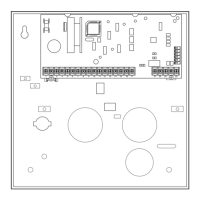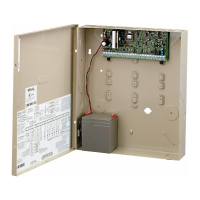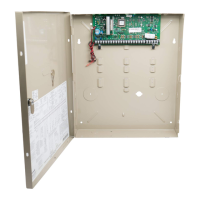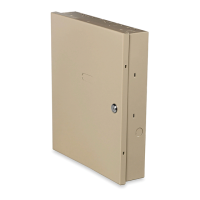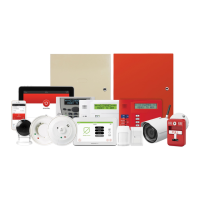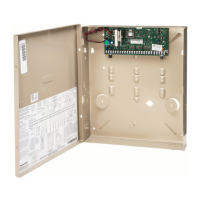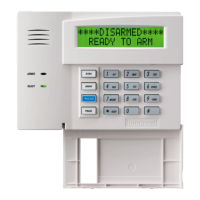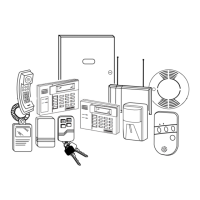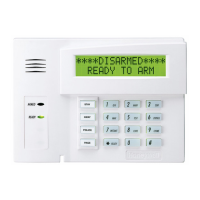
Do you have a question about the Honeywell ADEMCO VISTA-10P and is the answer not in the manual?
| Wi-Fi | No |
|---|---|
| Backup battery | Yes |
| Number of alarm zones | 22 |
| Connectivity technology | Wired & Wireless |
| Smartphone remote support | - |
| Number of supported remote controls | 8 |
| Maximum number of subscribers supported | 16 |
| Number of programmable transistor outputs | 2 |
| Control type | Buttons |
| Product color | Black, White |
| Input voltage | 16 V |
| Battery voltage | 12 V |
| Battery capacity | 4500 mAh |
| Number of door/window sensors | 0 pc(s) |
Provides a brief welcome and overview of system features.
Explains fundamental burglary, fire, and security code features.
Describes how the system divides protection areas.
Details how the system alerts users and monitoring stations.
Explains remote system access via phone.
Covers automatic and manual paging capabilities.
Describes the programmable function keys on the keypad.
Discusses the keypad's components and basic functions.
Details specific key functions and indicators.
Explains the use and security of wireless key fobs.
Time to leave premises after arming without triggering an alarm.
Time to disarm system after entering before an alarm sounds.
Conditions and messages related to exit delay errors.
Procedure to check for open zones before arming.
Using voice keypads to announce system status and faults.
Arms perimeter zones, allows occupants inside.
Arms perimeter and selected interior zones for higher security.
Arms perimeter zones with no entry delay.
Arms all zones, suitable for when premises are unoccupied.
Arms all zones with no entry delay.
Key sequences for arming the system in different modes.
Using function keys for quick arming.
Arming the system by pressing a key multiple times.
How to arm and disarm the system using a physical keyswitch.
Procedure to disarm the system and silence alarms.
Method to exclude specific zones from arming.
Automatically bypasses all currently open zones.
Alerts to door/window openings while the system is disarmed.
Voice announcements for zone openings in chime mode.
How to display the system's current date and time.
Procedure to adjust the system's date and time.
Activating emergency functions via dedicated keys.
Explains using keys to automate command sequences.
Demonstrates programming a sequence of commands.
Controlling external devices like lights via the system.
System sending alerts to pagers for events.
Sending a custom message to a pager.
Pager notification if system isn't disarmed by a set time.
Information on master and user codes.
Explains user access permissions and roles.
Procedure for managing user codes and permissions.
System's capability to automate events based on time.
Steps to program automated events.
How the system records and stores events.
Procedure to access recorded system events.
List of codes used to identify logged events.
Importance and procedure for weekly system checks.
Explains system messages for faults and low batteries.
Covers communication failures, receiver jams, and modem issues.
General advice for system upkeep.
How to temporarily silence low battery alerts.
Guidance on battery replacement for wireless devices.
Tips for cleaning and general handling of system components.
Overview of the fire alarm system's operation.
Procedure to stop fire alarms and clear displays.
How to reset smoke detectors after an alarm.
Procedure to trigger a fire alarm manually.
Guidelines for smoke detector placement.
Recommended steps for fire escape planning.
Quickly view which zones are open or faulted.
How to arm the system in various modes.
Procedure to disarm the security system.
How to activate emergency panic functions.
Explains sounds and displays for fixed-word keypads.
Explains sounds and displays for alpha-display keypads.
Compliance information for FCC and Industry Canada regulations.
Details for contacting a service representative.
A summary table of system features.
Table mapping function keys to capabilities.
Chart for tracking user programming and attributes.
Section for insured's details and system type.
Specifies recommended locations for smoke detectors.
Lists common locations for burglary sensors.
Discusses factors that can affect system performance and reliability.
Lists specific conditions not covered by the warranty.
Details limitations on implied warranties like merchantability.

